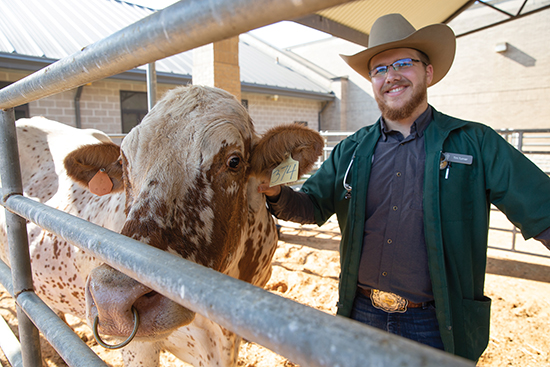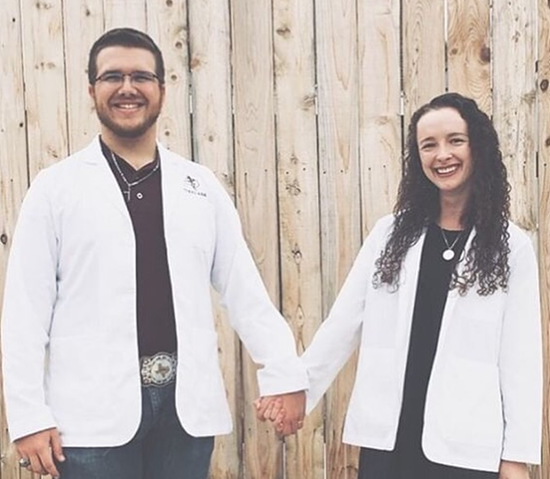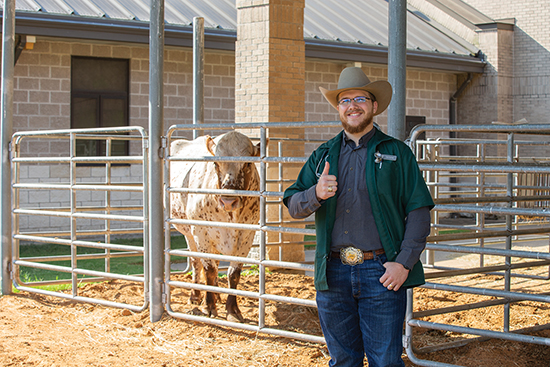Taking The Bull By The Horns
Story by Jennifer Gauntt, CVMBS Communications

Unlike with many of his peers, veterinary medicine wasn’t Timothy Turner’s first career choice.
“I wanted to be an astronaut first, but when I was 10, I was fishing with my grandpa, and we found a big piece of metal in Lake Nacogdoches,” he said. “We started asking around to find out what it could be and learned that it might be a piece of the Space Shuttle Columbia that had blown up several years earlier. That cured me of ever wanting to fly to space.”
While the Douglas, Texas, native got what he might believe to be a “late” start in veterinary medicine—considering that he would complete his homeschool curriculum and enter Stephen F. Austin State University (SFA) at 14—he began focusing the same energy and attention that were preparing him for a career in astrophysics into veterinary apprenticeship, shadowing under the watchful eye of Dr. Jim Weatherly ’80.
“After a year or two, Dr. Weatherly really started to notice that my interest was shifting from just, ’I love animals’ to really paying attention to and loving the work in medicine, especially with large animals,” Turner said. “So, he really took me under his wing. He pushed me and made me see what I would be doing in the future and how I can make the profession better. Even though he’s an old school veterinarian, he was always striving to make the profession better every single day.
“He taught me about veterinary medicine to the point that by the time I left there at 16 or 17 years old, he had begun joking, ‘You’re just going for a piece of paper now,’ because he gave me what knowledge he could in that time,” Turner said. “He basically is the reason I’m here today.”
At SFA, Turner studied animal science while working for Weatherly. When he wasn’t initially accepted into veterinary school at Texas A&M, he decided to stick around SFA and pursue degrees in chemistry and biochemistry. This ended up being fortuitous for Turner, as he met his wife (Meg, who is now a medical student at Texas College of Osteopathic Medicine in Fort Worth) in organic chemistry class.

Living apart while dating and then as a married couple presented its challenges; however, knowing that medical school was just a pit stop on the journey to a life together as doctors and the mutual understanding of the “grueling” nature of their curricula—along with conscious effort and FaceTime—have allowed the Turners to make it work.
It hasn’t hurt that their mutual love of medicine has brought them together in sometimes unexpected ways, such as when Meg’s cat, Charlie, ate a piece of string that became stuck in his intestines; because the cost of surgery was preclusive for medical students, the pair met at a family friend’s veterinary clinic, where, under the veterinarian’s watchful eye, Turner removed the foreign object.
“It was a great bonding moment, it saved her cat, and we got to be medically associated together,” Turner said. “It was just a really great experience.”
While Turner plans to devote his career primarily to bovine medicine, circumstances like that of Meg’s cat have also reinforced his love for small animal surgery.
“Charlie was very sick; in another couple of hours, he could have died, but we performed surgery for an hour and a half and he woke up happy, healthy, and ready to eat soft food. It’s just amazing, the turnaround surgery can have,” Turner said.
“A picture-perfect day in the life of Tim as a veterinarian would be spending three or four days a week out in the field working on cattle and then a couple of days locked away in small animal surgery,” he said. “Surgery is just very satisfying to me.”
That picture-perfect day would also include being back home in a small East Texas town, working at, and eventually owning, a mixed animal practice, with his wife also working at, or perhaps owning, a rural medicine practice.
Turner does admit that the concern among students about pay in rural communities, when associated with veterinary student debt, also concerns him, but, ultimately, his desire to help improve the veterinary situation in East Texas drives him to serve at home.

“I don’t necessarily think there’s a lack of large animal veterinarians in East Texas, but I don’t know that owners see the full value of our veterinary services. They can give their own antibiotics, they can buy a lot of vaccinations, they can de-horn—they can do a lot on their own,” Turner said. “Where veterinary medicine is having to shift is helping producers understand that our knowledge on nutrition, on selecting heifers, and other aspects of preventative medicine ultimately benefits the business.
“For example, if we select the cows that aren’t going to have problems calving, if I can get the number of calves that are getting stuck and having to be pulled down, then I help the producer. He’s not spending money on the dystocias; it takes less recovery time for the cow; the calf does better,” Turner said. “That’s something I’m going to have to actively go out and promote. I will have to be service-oriented and consult-oriented. So, yes, I am concerned about my debt, but I don’t think it’s insurmountable.”
That milk-glass-half-full mindset has driven Turner throughout his educational experience—whether it was learning the minutia of cattle medicine to provide services that he knows he’ll soon have to do on his own or the hard work it’s taken to get him where he is, Turner has simply enjoyed the ride.
“I really overworked myself that last year of undergrad, and so during veterinary school, I have made it a point to find the joy of what I’m doing each and every day,” Turner said. “I’ve always wanted to be an Aggie, ever since I was little, and I think a lot of it was Dr. Weatherly’s pride in the school. He was always proud of his ring and has worn it every day of his life since he’s gotten it.
“When I sit down and think about it, I’ve enjoyed every minute of veterinary school,” he said. “I know that it’s not a very common opinion, but if you told me that I had to start back from day one in order to be a veterinarian, I would do it all over again. I really would.”
###
Note: This story originally appeared in the Spring 2020 edition of CVM Today.
For more information about the Texas A&M College of Veterinary Medicine & Biomedical Sciences, please visit our website at vetmed.tamu.edu or join us on Facebook, Instagram, and Twitter.
Contact Information: Jennifer Gauntt, Director of Communications, Texas A&M College of Veterinary Medicine & Biomedical Sciences; jgauntt@cvm.tamu.edu; 979-862-4216


